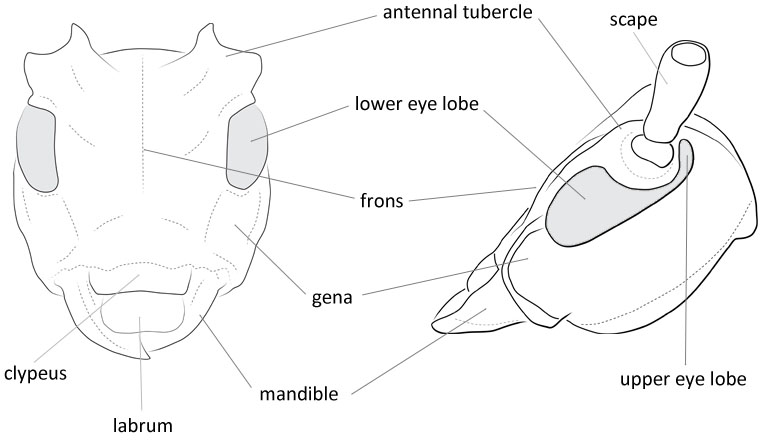Body length: 5.5–14 mm.
Eyes: eye interommatidial setaeseta:
a sclerotized hair-like projection of the cuticle
absent, eye deeply emarginateemarginate:
notched at the margin > half width, eye ommatidial density fine.
> half width, eye ommatidial density fine.
Antennaeantenna:
in larval and adult insects, paired segmented appendages, borne one on each side of the head, functioning as sense organs and bearing a large number of sensilla
: antennal length reaching/surpassing end of body, antennal flagellar segments elongateelongate:
much longer than wide
, scapescape:
the first proximal segment of the antenna smooth/punctate at apexapex:
smooth/punctate at apexapex:
end of any structure distad to the base
, antennal scapescape:
the first proximal segment of the antenna ≥ segment 3 or segment 3 > scapescape:
≥ segment 3 or segment 3 > scapescape:
the first proximal segment of the antenna .
.
Pronotumpronotum:
the upper and dorsal part of the prothorax
: pronotumpronotum:
the upper and dorsal part of the prothorax
shape transversetransverse:
broader than long
, pronotumpronotum:
the upper and dorsal part of the prothorax
lateral armature acute spinespine:
a protuberance with an acute (sharp) distal end
.
Prosternum: prosternal processprosternal process:
a posterior extension of the prosternum between the coxae dilated at apexapex:
dilated at apexapex:
end of any structure distad to the base
, procoxal cavities closed posteriorly.
Elytraelytron:
the leathery forewing of beetles, serving as a covering for the hind wings, commonly meeting opposite elytron in a straight line down the middle of the dorsum in repose
: elytral length reaching or close to end of abdomen, elytral apicesapex:
end of any structure distad to the base
rounded or truncatetruncate:
cut off squarely at the tip
, elytral color pattern present.
Legs: visible tarsomerestarsomere:
subdivision or article of the tarsus, usually numbering from two to five : 4, femora clavateclavate:
: 4, femora clavateclavate:
thickening gradually toward the tip
, protibial spursprotibial spur:
sclerotized spine(s) located at the distal tibia; can be single, double, or absent : 2, tarsal clawstarsal claw:
: 2, tarsal clawstarsal claw:
usually paired claws of the pretarsus, at the distal end of the leg simple.
simple.
Convex body. Pronotumpronotum:
the upper and dorsal part of the prothorax
without pubescence spots. Antennaeantenna:
in larval and adult insects, paired segmented appendages, borne one on each side of the head, functioning as sense organs and bearing a large number of sensilla
longer than the body in both sexes. Very narrow prosternum between the anterior coxae. Claviform femurs. Fifth abdominal segment barely longer than wide in the male, much longer in the female (adapted from Villiers 1946Villiers 1946:
Villiers A. 1946. Coléoptères Cérambycides de l'Afrique du Nord. Faune de l'Empire Français, ORSC Paris 5: 1–152, 275 figs. http://www.cerambycoidea.com/titles/villiers1946.pdf).
Can be separated from Acanthocinus by lack of pubescentpubescent:
downy; clothed with soft, short, fine, loosely set hair
spots on pronotumpronotum:
the upper and dorsal part of the prothorax
, antennal segments 3–5 not fimbriatefimbriate:
fringed with hairs of irregular length
beneath, and the terminal abdominal segment in males is not deeply notched but rounded or shallowly indented.
Palearctic
broadleaf; Abies, Picea, Pinus
21 spp. + 5 more sspp. (Leiopus); 9 spp. (Carinopus), feeding unknown. Conifers: L. (L.) montanus, L. (L.) nebulosus, L. (L.) linnei, L. (L.) stillatus, L. (L.) syriacus. There is some discussion surrounding the relationship with Acanthocinus and whether some or all of Leiopus should be synonymized.
Phrurus, Gistel, 1856
Leiopus, Audinet-Serville, 1835